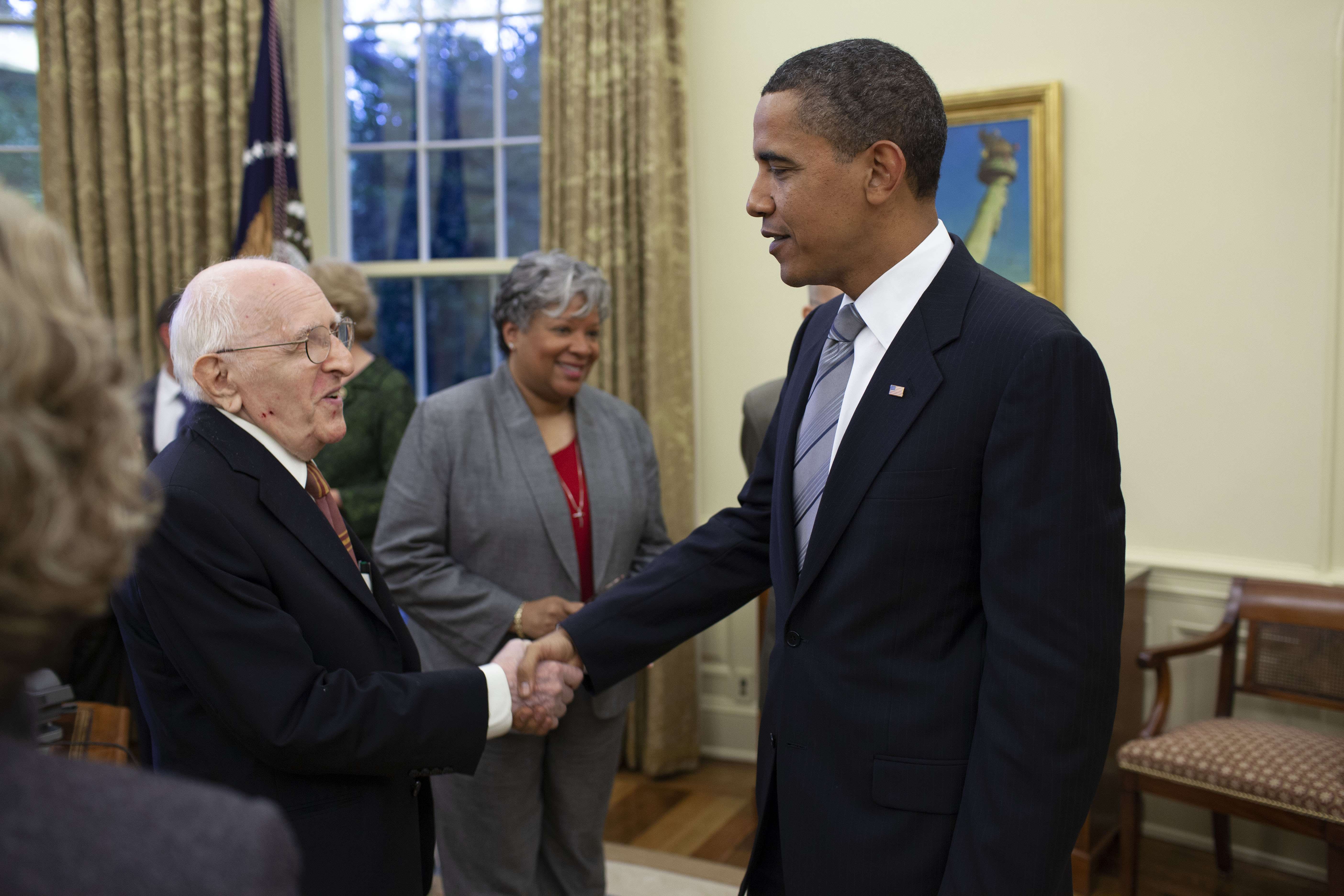President Barack Obama Greets Frank Kameny in the Oval Office
6/17/2009
Add to Favorites:
Add all page(s) of this document to activity:

The original caption for this photograph reads: "President Barack Obama talks with attendees after signing Presidential Memorandum regarding Federal Benefits and Non-Discrimination granting Federal employees with same sex partners more benefits, in the Oval Office of the White House in Washington, Wednesday, June 17, 2009." It was taken by White House Photographe Pete Souza.
In 1957, Franklin Kameny had been fired from his job in the Army Map Service as an astronomer because of his sexual orientation. This happened during a time known as the Lavender Scare. Beginning in the late 1940s and continuing through the 1960s, thousands of gay employees were fired or forced to resign from the federal workforce because of their sexuality. This wave of repression was also bound up with anti-Communism and fueled by the power of congressional investigation.
Kameny appealed his firing all the way to the Supreme Court. When that appeal failed in 1961, Kameny co-founded the Mattachine Society of Washington, D.C., which battled anti-gay discrimination in general and the federal government's exclusionary policies in particular. It was the first gay rights organization in the nation’s capital.
In 1963, Kameny became the first openly gay person to testify before Congress. He did so in defense of Mattachine after Congressman John Dowdy of Texas introduced a bill, H.R. 5990, to try to revoke the organization's permit to operate by amending the existing D.C. Charitable Solicitations Act. Dowdy’s bill stipulated that before granting a fundraising license, the D.C. Board of Commissioners had to certify that the grantee would "benefit or assist in promoting the health, welfare, and the morals of the District of Columbia."
Kameny went on to become a chief organizer of the first gay rights demonstrations in the nation’s capital. In 1965, he led protests at the White House, the Pentagon, and the Civil Service Commission. To remind the country that gay Americans lacked basic civil rights, Kameny and Mattachine joined with other gay rights organizations for "annual reminder" protests at Independence Hall in Philadelphia each Fourth of July from 1965 to 1969. Kameny later ran to become D.C.’s delegate to Congress. He lost the election, but his attempt marked the first time an openly gay candidate had run for Congress.
In 1975, the Civil Service Commission announced new rules stipulating that gay people could no longer be barred or fired from federal employment because of their sexuality. In 2009, President Barack Obama issued "Memorandum for the Heads of Executive Departments and Agencies on Federal Benefits and Non-Discrimination" in order "to achieve greater equality for the Federal workforce through extension to same-sex domestic partners of benefits currently available to married people of the opposite sex."
In 1957, Franklin Kameny had been fired from his job in the Army Map Service as an astronomer because of his sexual orientation. This happened during a time known as the Lavender Scare. Beginning in the late 1940s and continuing through the 1960s, thousands of gay employees were fired or forced to resign from the federal workforce because of their sexuality. This wave of repression was also bound up with anti-Communism and fueled by the power of congressional investigation.
Kameny appealed his firing all the way to the Supreme Court. When that appeal failed in 1961, Kameny co-founded the Mattachine Society of Washington, D.C., which battled anti-gay discrimination in general and the federal government's exclusionary policies in particular. It was the first gay rights organization in the nation’s capital.
In 1963, Kameny became the first openly gay person to testify before Congress. He did so in defense of Mattachine after Congressman John Dowdy of Texas introduced a bill, H.R. 5990, to try to revoke the organization's permit to operate by amending the existing D.C. Charitable Solicitations Act. Dowdy’s bill stipulated that before granting a fundraising license, the D.C. Board of Commissioners had to certify that the grantee would "benefit or assist in promoting the health, welfare, and the morals of the District of Columbia."
Kameny went on to become a chief organizer of the first gay rights demonstrations in the nation’s capital. In 1965, he led protests at the White House, the Pentagon, and the Civil Service Commission. To remind the country that gay Americans lacked basic civil rights, Kameny and Mattachine joined with other gay rights organizations for "annual reminder" protests at Independence Hall in Philadelphia each Fourth of July from 1965 to 1969. Kameny later ran to become D.C.’s delegate to Congress. He lost the election, but his attempt marked the first time an openly gay candidate had run for Congress.
In 1975, the Civil Service Commission announced new rules stipulating that gay people could no longer be barred or fired from federal employment because of their sexuality. In 2009, President Barack Obama issued "Memorandum for the Heads of Executive Departments and Agencies on Federal Benefits and Non-Discrimination" in order "to achieve greater equality for the Federal workforce through extension to same-sex domestic partners of benefits currently available to married people of the opposite sex."
This primary source comes from the Collection BHO-WHPO: Records of the White House Photo Office (Obama Administration).
National Archives Identifier: 157649816
Full Citation: Photograph P061709PS-0515; President Barack Obama Greets Frank Kameny in the Oval Office; 6/17/2009; Presidential Photographs, 1/20/2009 - 1/20/2017; Collection BHO-WHPO: Records of the White House Photo Office (Obama Administration); Barack Obama Presidential Library, Hoffman Estates, IL. [Online Version, https://www.docsteach.org/documents/document/obama-kameny, April 26, 2024]Activities that use this document
- The Long Struggle for LGBTQ+ Civil Rights
Created by the National Archives Education Team
Rights: Public Domain, Free of Known Copyright Restrictions. Learn more on our privacy and legal page.



